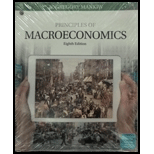
Principles of Macroeconomics, Loose-Leaf Version
8th Edition
ISBN: 9781337096881
Author: Mankiw, N. Gregory
Publisher: South-Western College Pub
expand_more
expand_more
format_list_bulleted
Question
Chapter 14, Problem 4CQQ
To determine
Moral hazard and adverse selection.
Expert Solution & Answer
Trending nowThis is a popular solution!

Students have asked these similar questions
A linear programming computer package is needed.
As part of the settlement for a class action lawsuit, Hoxworth Corporation must provide sufficient cash to make the following annual payments (in thousands of dollars).
6
Year
1
23.
4
Payment 160
185 210 255 285
430
The annual payments must be made at the beginning of each year. The judge will approve an amount that, along with earnings on its investment, will cover the annual payments. Investment of the funds will be limited to savings (at 4% annually) and government
securities, at prices and rates currently quoted in The Wall Street Journal.
Hoxworth wants to develop a plan for making the annual payments by investing in the following securities (par value = $1,000). Funds not invested in these securities will be placed in savings.
Security Current Price
1
$1,055
Rate (%)
Years to Maturity
6.750
3
2
$1,000
5.125
Assume that interest is paid annually. The plan will be submitted to the judge and, if approved, Hoxworth will be required to…
Put the sections of Cornell notes in the order of completion.
agree or disagree with the post
Hi Class!
Egyptian dates are much sweeter!
Due largely to their climate and geography, Egypt, Saudi Arabia, Algeria, and Iran produce more dates than either the US or Canada. Dates grow best in hot dry climates with long dry growing seasons, which these nations naturally offer. They also produce a lot of dates because of their extensive agricultural, infrastructure, and centuries-old date-growing expertise. Conversely, the U.S., there aren't many places in Canada and California that are suitable for date farming, only a select few, like the Coachella Valley, in California can produce dates on a large scale. Although California produces some dates, it is not as much as countries like Saudi Arabia and Egypt. Depending only on U.S., because of increased labor and production costs, dates grown in this way may have a limited supply and raise prices. We can obtain a greater supply of dates at competitive prices while maintaining consistent quality by…
Chapter 14 Solutions
Principles of Macroeconomics, Loose-Leaf Version
Knowledge Booster
Similar questions
- In 1932 babe Ruth made $75,000. How much is that in todays dollars please give the right answer step by steparrow_forwardEvaluate machine XYZ when MARR is 12% per year. Pertinent data are as follows: Machine XYZ Investment cost Expected life Market (salvage) value Annual revenue Annual expenses $10,000 5 years $1,000 $8,000 $4,000 How much is the excess of the cash flow using the Annual Worth Method? Blank 1 Calculate the External Rate of Return. Blank 2 Compute the payback period of the investment. Blank 3 Would you recommend this investment? Explain briefly. Blank 4arrow_forwardPlease make sure to answer each step and show work. Thank you!arrow_forward
- HW Ch5 Calculate the daily total revenue when the market price is $180, $160, $140, $120, $100, $80, $60, and $40 per bippitybop. Then, use the green point (triangle symbol) to plot the daily total revenue against quantity corresponding to these market prices on the following graph. 2 @ 3840 3520 3200+ 2880 2560+ 2240 TOTAL REVENUE (Dollars) 1920 1600 1280 960 + 640+ 0 0 8 16 24 32 40 48 56 64 72 80 QUANTITY (Bippitybops per day) Total Revenue ? According to the midpoints formula, the price elasticity of demand between points A and B on the initial graph is approximately . Suppose the price of bippitybops is currently $60 per bippitybop, shown as point A on the initial graph. Because the price elasticity of demand between points A and B is , a $20-per-bippitybop decrease in price will lead to MacBook Air in total revenue per day. F2 80 F3 #3 $ 4 5 6 F6 < F7 * 8 & 27 DII 8 F8 F9 F10 61 0 W E R T Y U 0 P S D LL F G H J K Larrow_forwardNot use ai pleasearrow_forwardChina is a leader in international trade, has one of the highest GDPs, and currently holds the largest foreign exchange reserve in the world. Is it fair for China to fix its currency by undervaluing it on the market? How does keeping its currency undervalued give it a favorable position in international trade? What about from the viewpoints of international companies and consumers?arrow_forward
arrow_back_ios
SEE MORE QUESTIONS
arrow_forward_ios
Recommended textbooks for you
 Essentials of Economics (MindTap Course List)EconomicsISBN:9781337091992Author:N. Gregory MankiwPublisher:Cengage Learning
Essentials of Economics (MindTap Course List)EconomicsISBN:9781337091992Author:N. Gregory MankiwPublisher:Cengage Learning Brief Principles of Macroeconomics (MindTap Cours...EconomicsISBN:9781337091985Author:N. Gregory MankiwPublisher:Cengage Learning
Brief Principles of Macroeconomics (MindTap Cours...EconomicsISBN:9781337091985Author:N. Gregory MankiwPublisher:Cengage Learning Principles of Economics 2eEconomicsISBN:9781947172364Author:Steven A. Greenlaw; David ShapiroPublisher:OpenStax
Principles of Economics 2eEconomicsISBN:9781947172364Author:Steven A. Greenlaw; David ShapiroPublisher:OpenStax Principles of Macroeconomics (MindTap Course List)EconomicsISBN:9781285165912Author:N. Gregory MankiwPublisher:Cengage Learning
Principles of Macroeconomics (MindTap Course List)EconomicsISBN:9781285165912Author:N. Gregory MankiwPublisher:Cengage Learning Principles of Economics, 7th Edition (MindTap Cou...EconomicsISBN:9781285165875Author:N. Gregory MankiwPublisher:Cengage Learning
Principles of Economics, 7th Edition (MindTap Cou...EconomicsISBN:9781285165875Author:N. Gregory MankiwPublisher:Cengage Learning Principles of Economics (MindTap Course List)EconomicsISBN:9781305585126Author:N. Gregory MankiwPublisher:Cengage Learning
Principles of Economics (MindTap Course List)EconomicsISBN:9781305585126Author:N. Gregory MankiwPublisher:Cengage Learning

Essentials of Economics (MindTap Course List)
Economics
ISBN:9781337091992
Author:N. Gregory Mankiw
Publisher:Cengage Learning

Brief Principles of Macroeconomics (MindTap Cours...
Economics
ISBN:9781337091985
Author:N. Gregory Mankiw
Publisher:Cengage Learning

Principles of Economics 2e
Economics
ISBN:9781947172364
Author:Steven A. Greenlaw; David Shapiro
Publisher:OpenStax

Principles of Macroeconomics (MindTap Course List)
Economics
ISBN:9781285165912
Author:N. Gregory Mankiw
Publisher:Cengage Learning

Principles of Economics, 7th Edition (MindTap Cou...
Economics
ISBN:9781285165875
Author:N. Gregory Mankiw
Publisher:Cengage Learning

Principles of Economics (MindTap Course List)
Economics
ISBN:9781305585126
Author:N. Gregory Mankiw
Publisher:Cengage Learning